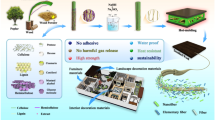Abstract
Cellulosic fibres retrieved from annual agricultural by-products offer diverse advantages when applied as a main ingredient in biocomposite building materials. Within this paper work, the application possibility of non-wood straw fibres in innovative building products is highlighted. Fabrication efficiency is reached here through reducing the number of industrial processes and additives needed to manufacture the final biocomposite products. The natural mineral contents of the straw selected (rice straw) were investigated at 20% fibre load as active flame-retardant fillers in combination with two types of bio-based synthesized thermoplastics [poly-lactic acid (PLA) and Lignin]. Flammability behavior and morphological examinations of the resulted building materials were tested. Through post-fabrication techniques including vacuum thermoforming processes, a variety of cladding panels with different architectural designs were achieved. The applied fibres were not chemically treated. Instead, the fibres were mechanically densified, maintaining the inner natural minerals contents. The results have shown promising possibility of applying straw fibres as partial replacement of classic flame-retardants especially in combination with bioplastics. The straw based green biocomposites were proved to offer high ecological, economical and aesthetic input in the building industry.

(Photo: Dahy)


Similar content being viewed by others
References
Plastics Europe—Association of Plastics Manufacturers: Plastics—the Facts 2014/2015: An analysis of European plastics production, demand and waste data, Belgium (2015) http://www.plasticseurope.org/documents/document/20150227150049-final_plastics_the_facts_2014_2015_260215.pdf Accessed 04 Feb 2017
Plank, J.: Applications of biopolymers in construction engineering. Biopolym. Online (2005). https://doi.org/10.1002/3527600035.bpola002
Endres, H.J., Siebert-Raths, A.: 10.19—performance profile of biopolymers compared to conventional plastics. In: Polymer Science: A Comprehensive Reference, vol. 10, pp 317–353 (2012). https://doi.org/10.1016/b978-0-444-53349-4.00270-3
Horrocks, A.R.: Flame retardant challenges for textiles and fibres: new chemistry versus innovatory solutions. Polym. Degrad. Stab. 96, 377–392 (2011)
Salmeia, K.A., Jovic, M., Ragaisiene, A., Rukuiziene, Z., Milasius, R., Mikucioniene, D., Gaan, S.: Flammability of cellulose-based fibers and the effect of structure of phosphorus compounds on their flame retardancy. Polymers 8, 293 (2016)
Gaan, S., Sun, G.: Effect of phosphorus and nitrogen on flame retardant cellulose: a study of phosphorus compounds. J. Anal. Appl. Pyrol. 78, 371–377 (2007)
Kozłowski, R., Władyka-Przybylak, M.: Flammability and fire resistance of composites reinforced by natural fibers. Polym. Adv. Technol. 19, 446–453 (2008)
Matkó, S., Toldy, A., Keszei, S., Anna, P., Bertalan, G., Marosi, G.: Flame retardancy of biodegradable polymers and biocomposites. Polym. Degrad. Stab. 88, 138–145 (2005)
Yuan, T.Q., Sun, R.C.: Introduction. In: Sun, R.-C. (ed.) Cereal Straw as a Resource for Sustainable Biomaterials and Biofuels: Chemistry, Extractives, Lignins, Hemicelluloses and Cellulose, pp. 1–5. Elsevier, Amsterdam (2010)
FAO: Food and Agriculture Organization of the United Nations: Cereal Supply and Demand Brief dataset (2016). http://www.fao.org/worldfoodsituation/csdb/en/ Accessed 02 Jan 2017
Yang, Y., Reddy, N.: High Quality and Long Natural Cellulose Fibers from Rice Straw and Method of Production Rice Straw Fibers. US Patent 2006/0180285 A1 (2006)
Buzarovska, A., Bogoeva, G.G., Grozdanov, A., Avella, M., Gentile, G., Errico, M.: Potential use of rice straw as filler in eco-composite materials. Aust. J. Crop. Sci. 1, 37–42 (2008)
Pekarovic, J., Pekarovicova, A., Fleming, P.D.: Preparation of biosilica-enriched filler and an example of its use in a papermaking retention system. J Papir a Celuloza 63(7–8), 218–222 (2008)
Thompson, D.N., Foust, T.D., Hess, J.R., Hoskinson, R.L., Houghton, T.R., Lacey, J.A., Shaw, P.G., Grant, D.R.: Selective harvest of higher value wheat straw components. In: Crockett, J., Peterson, C.L. (eds.) Bioenergy 2002—Bioenergy for the Environment, Boise (2002)
Dahy, H.: Biocomposite materials based on annual natural fibres and biopolymers—Design, fabrication and customized applications in architecture. J. Constr. Build Mater. 147, 212–220 (2017)
Dahy, H., Knippers, J.: Agricultural residues applications in contemporary building industry. In: Cruz, P. J.S. (ed.) Structures and architecture concepts, applications and challenges, pp. 2108–2115. CRC Press, Taylor &Francis Group, London (2013)
Jenkins, B.M.: Properties of biomass. In: Wiltsee, G. (ed.) Biomass Energy Fundamentals, Vol. 2: Appendices, EPRI TR-102107. Electric Power Research Institute, Palo Alto (1993)
Dahy, H.: Agro-fibres Biocomposites Applications and Design Potentials in Contemporary Architecture: Case Study: Rice Straw Biocomposites, Forschungsbericht Nr. 38, Insitut für Tragkonstruktionen und Konstruktives Entwerfen, Universität Stuttgart, Germany (2015). https://doi.org/10.18419/opus-113
Jiang-yu, F., Xue-long, M.: In vitro simulation studies of silica deposition induced by lignin from rice. J. Zhejiang Univ. Sci. B 7(4), 267–271 (2006)
Acknowledgements
The author thank the Institute for Agricultural Technology at the University of Hohenheim for helping in the fibre densification, the Institute for Food Chemistry at the University of Hohenheim for helping in the fibre analysis, the Institute for Polymer Technology at the University of Stuttgart for the SEM analysis and density measurements, the Institute for Inorganic Chemistry—University of Stuttgart for the support with the fire tests as well as the company Tecnaro for helping in the straw-lignin compounding process, the State Academy of Fine Arts in Stuttgart for the vacuum thermoforming machines’ support, the architecture students of the University of Stuttgart who participated in designing and fabricating the thermoformed panels in the ‘Bio-Materials Xperience Seminar’ in SS16, and ‘Eco-Room Practice Seminar’ in WS 15/16 supervised by the author and the Agency of Renewable Resources (FNR) under the German Ministry for Consumer Protection, Food and Agriculture (BMEL) for funding the project PLUS with the funding number FKZ: 22008413 in which the extrusion processes were investigated.
Author information
Authors and Affiliations
Corresponding author
Rights and permissions
About this article
Cite this article
Dahy, H. Efficient Fabrication of Sustainable Building Products from Annually Generated Non-wood Cellulosic Fibres and Bioplastics with Improved Flammability Resistance. Waste Biomass Valor 10, 1167–1175 (2019). https://doi.org/10.1007/s12649-017-0135-3
Received:
Accepted:
Published:
Issue Date:
DOI: https://doi.org/10.1007/s12649-017-0135-3




